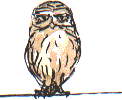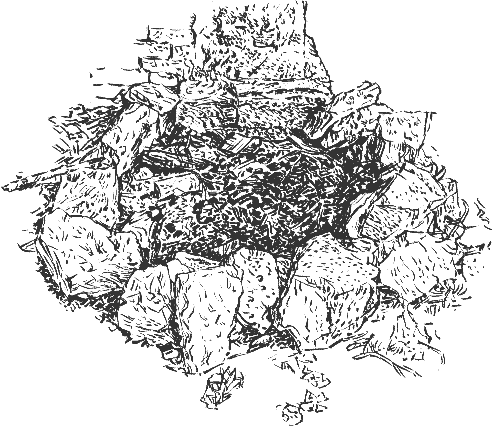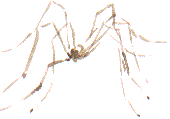
|
BonfireFriday, 24th January 2003, West Yorkshire |
![]()
![]()
![]()
![]() Rocks |
History |
Workshop |
Links |
Home Page
Rocks |
History |
Workshop |
Links |
Home Page
![]()

Some of the rocks that were arranged in a circle for this bonfire have become reddened by the heat, others appear to have cracked. Another mark, reddish with a black edge, has been added to the patina of age on the pillar base. The smell of cold charcoal reminds me of the old cottage on Skokholm Island, with its open fire, which always smelt like that the morning after.
I've done general views to describe what the Deer Shelter is like but for me the simplest details make the best drawings. It's a milder day and the welcome sunlight seems to help me describe the forms, even though this is essentially a line drawing.
 You
have to draw the ashes and charcoal with the same concentration - and
hopefully in the same relaxed manner - as you do the rocks and pillar,
the structural part of the drawing. No part of the drawing is especially
more interesting than the other. Each offers it's challenge, even the
challenge of depicting a scatter of charcoal.
You
have to draw the ashes and charcoal with the same concentration - and
hopefully in the same relaxed manner - as you do the rocks and pillar,
the structural part of the drawing. No part of the drawing is especially
more interesting than the other. Each offers it's challenge, even the
challenge of depicting a scatter of charcoal.
A harvestman spider trundles under one of the stones.
Just one more thing about that bonfire; dust and ashes. Oliver Reed once appeared in a scene in Women in Love at Bretton with Glenda Jackson and a number of highland cattle. His last words on screen, if I remember rightly were 'Dust and ashes', which he says as he is assassinated in Gladiator (film buffs, please tell me if I've got any of that wrong).
Objets trouvés
 As
you'll have noticed from previous pages, I've decided to concentrate
my drawings on the immediate surroundings of the Deer Shelter. If I
was including the Shelter in the local guide booklets I've been writing
and illustrating during the past five years I'd have come along and
taken two photographs, a general view and a detail and I would probably
have worked these up into a sketch at home. I realised when I visited
an old barn at Malham while researching my last booklet that I could
have done the whole book on that one barn. I'm trying to capture the
richness of a single, special location and, now that I've covered the
general views and the special details such as the fossils, I'm finding
that I'm attracted by some of the smaller details - even just found
objects like this reddish rubber work glove which must have been lying
in grass since last summer.
As
you'll have noticed from previous pages, I've decided to concentrate
my drawings on the immediate surroundings of the Deer Shelter. If I
was including the Shelter in the local guide booklets I've been writing
and illustrating during the past five years I'd have come along and
taken two photographs, a general view and a detail and I would probably
have worked these up into a sketch at home. I realised when I visited
an old barn at Malham while researching my last booklet that I could
have done the whole book on that one barn. I'm trying to capture the
richness of a single, special location and, now that I've covered the
general views and the special details such as the fossils, I'm finding
that I'm attracted by some of the smaller details - even just found
objects like this reddish rubber work glove which must have been lying
in grass since last summer.
I feel there's some poetic significance in such objects. Well, there can be, it depends how you look at them. They're fun to draw, compared to the complex, cluttered general views, and they will add a welcome touch of visual variety if I get around, as I intend to, to putting some of the sketches in a book.
 If
you're drawing it doesn't matter where a moss-covered rock is - it could
be on Dartmoor, in a temple garden in Kyoto or here where they're just
dumped against a drystone wall. Wherever they are they've got that ancient
organic look - the stuff of haiku.
If
you're drawing it doesn't matter where a moss-covered rock is - it could
be on Dartmoor, in a temple garden in Kyoto or here where they're just
dumped against a drystone wall. Wherever they are they've got that ancient
organic look - the stuff of haiku.
I made the drawing as accurately as I could but I'm not overly concerned about the structure of the drawing as I have been when sketching the brick vaults of the Shelter.
I feel that drawing real, plain, ordinary rocks direct from nature is probably better for me at the moment than staying at home and trying to learn the Chinese brush technique for painting idealised rocks. Even when drawing something as mundane as that bonfire I realise that every rock is slightly different, each has its own character.
The Rudiments of Wisdom
 There's
a strident 'Wiouu! Wiouu! Wiouu!'; a call like one of those party blowers
that uncurl when you blow them. I'm sure it's a little owl
and it must be within 20 yards of me, somewhere in the direction of
the horse chestnut, but I don't spot it. Wisdom built her habitation
of seven pillars, the owl was sacred to Minerva, goddess of wisdom,
so for a little 'habitation' boasting just two pillars the little owl
seems to comfortably fit the bill, here at the Deer Shelter.
There's
a strident 'Wiouu! Wiouu! Wiouu!'; a call like one of those party blowers
that uncurl when you blow them. I'm sure it's a little owl
and it must be within 20 yards of me, somewhere in the direction of
the horse chestnut, but I don't spot it. Wisdom built her habitation
of seven pillars, the owl was sacred to Minerva, goddess of wisdom,
so for a little 'habitation' boasting just two pillars the little owl
seems to comfortably fit the bill, here at the Deer Shelter.
I just hope I get a glimpse of it one day!![]()
![]()
Next page | Previous
page | This
day in 2000 | This
month | Nature
Diary | Home
Page
![]()